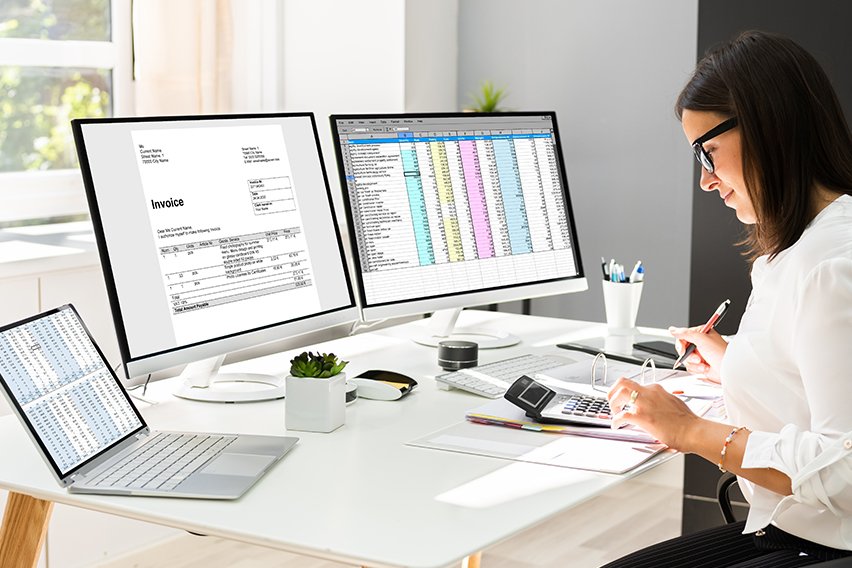Account Balance: Definition, Types, and Examples

Your small business bank account may be ever-changing as funds come and go. Checking your balance and managing your transactions will give you key insight on your business growth. Learn about your account balance, balance types, and examples in this in-depth article.
Here’s What We’ll Cover:
Available Balance vs Total Balance
More Accounting Resources for Businesses
What is Account Balance?
When you log into an online banking account, the first thing you will see is your account balance. Account Balance is the amount of funds you have available in a given financial account; such as a checking or savings account. The given balance reflects the net amount available after credits and debits.

Available Balance vs Total Balance
Online banking platforms make it easy to check your account balances in real time. When you check your bank account balance online, there may be two different numbers that you see; available balance and total balance.
Available Balance
Often, upon checking your account you may see ‘pending’ transactions that show recent payments processing– these are transactions that have not fully gone through yet.
Depending on the service or vendor that charged your account, there may be a delay in their banking system connecting with yours. In this case, your bank will factor that charge into your overall account balance, and will mark the payment as ‘pending’, and give you an available balance.
|
Total Balance
Your account total balance is the previous day’s ending balance, given all fully processed transactions. Pending transactions are not reflecting in your total balance. Your total account balance does not reflect any checks or other initiated balance transactions that have not been fully processed.
|
Types of Accounts
There are many different types of accounts that hold funds available for spending; whether you want a personal checking account that allows you to use your debit card at ATM’s, a business account that grows with time, or a long-term retirement account. Any accounts that you can deposit or withdraw from will have an account balance available for you to check.
Primary Bank Account Types:
- Checking Account
- Savings Account
- Certification of Deposit (CD)
- Money market account
- Individual retirement accounts (IRA’s)
Once you understand the different types of accounts that banks have to offer, you can decide which type works best for you and your personal and business banking needs.
Tip: If you notice an unauthorized transaction or fraudulent charge on your account, report the charge ASAP. If you report the fraud to your bank within two days from when you discovered it, your liability for the charges tops out at $50. |
Account Types and Examples
Checking Account
Checking accounts are used for everyday spending–whether your personal checking or business checking account. You can link a debit card to this account to use for purchases or withdrawal or deposit cash from ATMs (keep in mind that some ATM’s may charge card fees). Checking accounts do not build interest but they’re great for daily transactions and allow you to deposit cash, write checks, and pay bills.
- Good for daily spending and paying bills
- Allows credit or debit card purchases
- Personal checking or business checking accounts available
- 24-hour access to funds and online banking
- Do not collect interest
- ATM cash withdrawal
Savings Account
A savings account is a great way to start building and growing your savings in an interest earning, secure setting. You still have full-time access to this account like a checking account, but it offers additional services, and it’s a separate space where you can park cash you’d otherwise be tempted to spend.
- Good for beginner investors
- Builds slow interest
- Pairs well with a personal checking account
- Electric fund transfers between savings and checking accounts
Certification of Deposit (CD)
A CD is similar to a savings account except it holds your funds for a fixed term. Whether it be 3-months or 6-months, you choose a set time for your funds to sit a build interest without interference.
CD accounts build interest faster than typical savings accounts– but you have to be committed to leaving your funds be, to avoid early withdrawal fees.
- Good for large amounts of funds to grow interest
- No-risk
- Builds interest faster than standard savings account
- Must commit to leaving funds in account for full fixed term
Money Market Account
A money market account combines the features or both a savings and checking account. You can withdraw and deposit funds from this account and write checks as well as gain interest. If you want to keep all of your funds in one, flexible account where you have access to balance details, can use your card at ATM’s, and additional services, a money market account may be a good fit.
- Benefits of a combined checking and savings account
- Gains interest
- Write check and withdraw cash
- Access to balance details
- ATM balance inquiry
Individual Retirement Accounts (IRAs)
An IRA is like a long-term savings account. These accounts are specific for saving towards retirement. They’re unique because they allow you to invest your money in the stock market, and they offer tax advantages. Speaking to an accounting professional will help you establish a successful IRA as they can walk you through the best low-risk strategy for long-term investment.
- Good for long-term investing
- Tax breaks
- Invest money in stock market
Learning the different bank account types and how they differ will help you set up the right system for your personal or business banking needs.
Account Benefits
Whatever account type you choose, there are some key features to look for that will benefit your banking experience:
- Available Balance & Total Balance
- Direct Deposit
- Mobile Deposit
- Customer Service Support
- Fraud detection
- Daily balance and monthly balance statements

Takeaways
Learning how to check your bank accounts is an essential tool for an individual, whether it be your personal savings account, businesses checking account, or freelance money market account.
Choose an account type that fits best with your lifestyle or business plan and commit to staying updated on your balance details, transaction history, and growing investment strategies.
More Accounting Resources for Businesses
RELATED ARTICLES

 What is Capital Budgeting? – Definition, Process & Techniques
What is Capital Budgeting? – Definition, Process & Techniques Gross Pay vs. Net Pay: What’s the Difference
Gross Pay vs. Net Pay: What’s the Difference What is Cash Flow Formula & How To Calculate It?
What is Cash Flow Formula & How To Calculate It? What is EOQ Formula (Economic Order Quantity)?
What is EOQ Formula (Economic Order Quantity)? What Is Finance? Definition and Types of Finance
What Is Finance? Definition and Types of Finance What is Compound Interest & How To Calculate It?
What is Compound Interest & How To Calculate It?